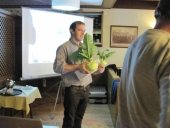








 )
) 



Gary




Principal - Terra Phoenix Design
http://TerraPhoenixDesign.com




Brenda
Bloom where you are planted.
http://restfultrailsfoodforestgarden.blogspot.com/








Brenda
Bloom where you are planted.
http://restfultrailsfoodforestgarden.blogspot.com/








For 6 weeks one summer our bees attacked a King Stropharia bed, exposing the mycelium to the air, and suckled the sugar-rich cytoplasm from the wounds. A continuous convoy of bees could be traced, from morning to evening, from our beehives to the mushroom patch, until the bed of King Stropharia literally collapsed. When a report of this phenomenon was published in Harrowsmith Magazine (Ingle, 1988), bee keepers across North America wrote me to explain that they had been long mystified by bees' attraction to sawdust piles. Now it is clear the bees were seeking the underlying sweet mushroom mycelium.
"the qualities of these bacteria, like the heat of the sun, electricity, or the qualities of metals, are part of the storehouse of knowledge of all men. They are manifestations of the laws of nature, free to all men and reserved exclusively to none." SCOTUS, Funk Bros. Seed Co. v. Kale Inoculant Co.




My books, movies, videos, podcasts, events ... the big collection of paul wheaton stuff!





|
Tongue wrestling. It's not what you think. And here, take this tiny ad. You'll need it.
the permaculture bootcamp in winter (plus half-assed holidays)
https://permies.com/t/149839/permaculture-projects/permaculture-bootcamp-winter-assed-holidays
|

